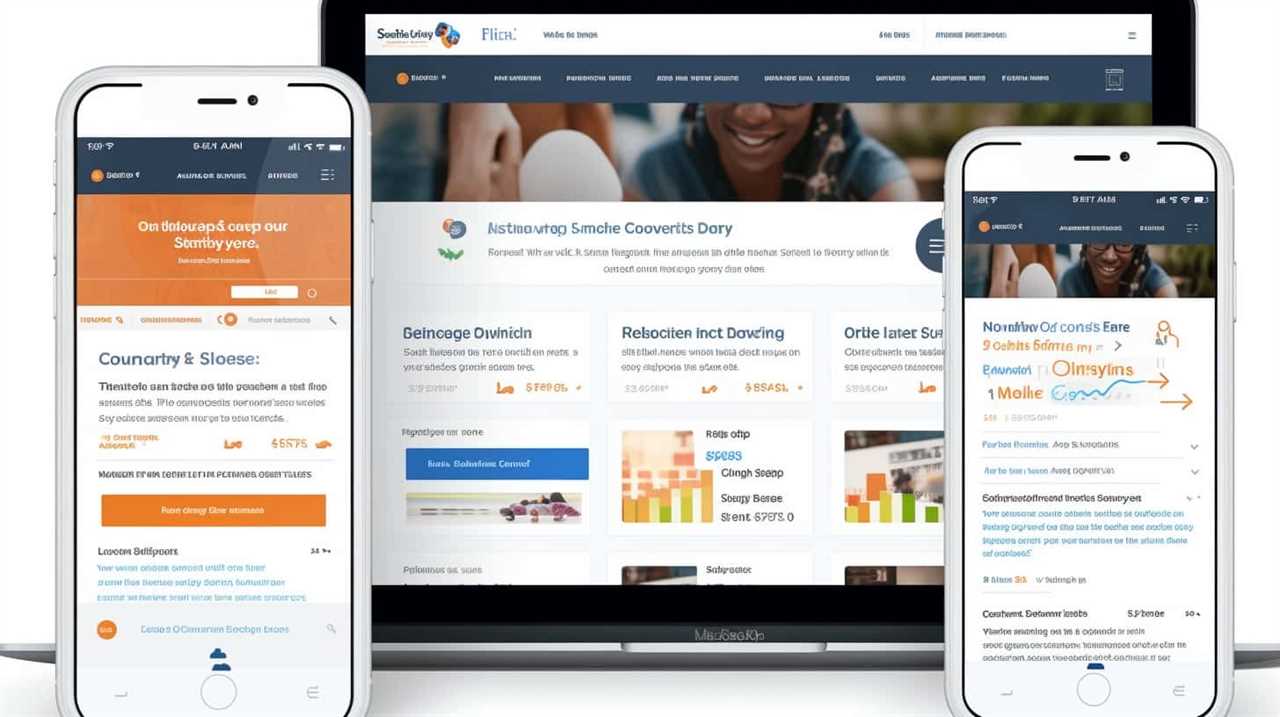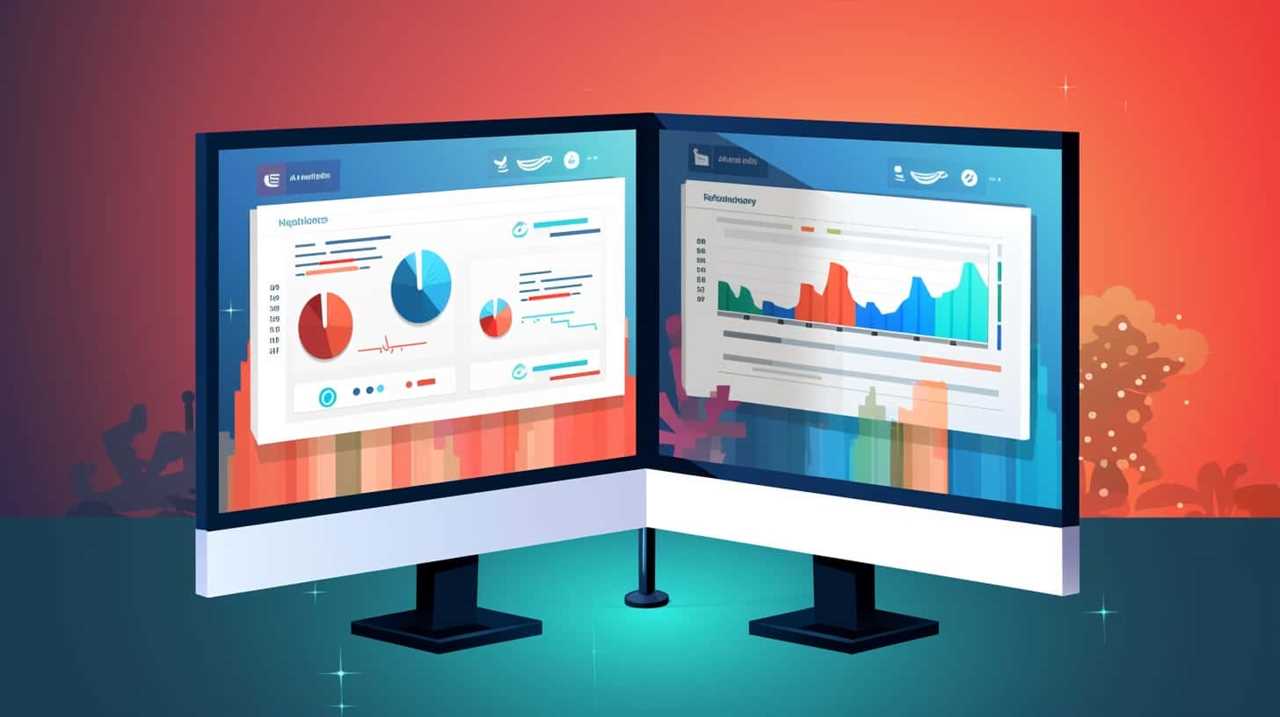The importance of optimizing page speed and conducting tests for mobile usability in creating designs that are mobile-friendly and for search engine optimization.
Are you ready to take your independent music label to new heights online? We’ve got the key to hitting all the high notes in the digital world: SEO.
In this article, we’ll show you how to optimize your website, create engaging content, and stay on top of the latest trends.
With our expert tips and tricks, your label will soar to the top of search engine rankings, attracting a larger audience and gaining the recognition you deserve.

Let’s get started on this journey to online success together.
Key Takeaways
- Conduct competitor analysis and stay updated with industry trends to identify areas for improvement in SEO strategies for independent music labels.
- Target niche audiences and capitalize on long-tail keywords to improve search engine rankings and attract the right audience.
- Optimize website for mobile devices and ensure user-friendly navigation to enhance visibility and provide a seamless user experience.
- Utilize diverse content formats, collaborations, social media marketing, and SEO techniques to create and promote engaging content for independent music labels.
Understanding the Basics of SEO
To begin our exploration of the subtopic ‘Understanding the Basics of SEO’, let’s dive into the importance of optimizing websites for search engines. In today’s digital landscape, having a strong online presence is essential for success. This is where Search Engine Optimization (SEO) comes into play.
SEO involves making strategic changes to your website to improve its visibility and ranking on search engine results pages.
One important aspect of SEO is conducting competitor analysis. By analyzing your competitors’ websites and their SEO strategies, you can gain valuable insights into what’s working in your industry and identify areas for improvement. This analysis allows you to stay one step ahead and make informed decisions about your own SEO efforts.

Another crucial aspect of SEO is optimizing your website for mobile devices. With the increasing use of smartphones and tablets, it’s vital to ensure that your website is mobile-friendly. Mobile optimization involves creating a responsive design, where your website adapts to different screen sizes, loads quickly, and provides a seamless user experience. This not only improves your website’s visibility on mobile search results but also enhances user satisfaction and engagement.
Conducting Keyword Research for Music Labels
When it comes to maximizing online visibility for music labels, conducting keyword research is crucial.
By identifying relevant music industry keywords, we can optimize our website and content to attract the right audience.
It’s important to target niche audiences and capitalize on long-tail keywords to increase our chances of ranking higher in search engine results.

Relevant Music Industry Keywords
As we delve into the topic of conducting keyword research for music labels, it’s essential to understand the importance of identifying relevant keywords within the music industry. By targeting the right keywords, independent music labels can ensure that their online presence aligns with current music industry trends and effectively reaches their target audience.
Here are three key elements to consider when conducting keyword research for music labels:
- Music industry trends: Stay up-to-date with the latest happenings in the music industry to identify keywords that are relevant and trending. This allows music labels to create content that resonates with their audience and capitalizes on popular topics.
- Digital marketing strategies: Incorporate keywords that align with your digital marketing efforts. This includes optimizing website content, social media posts, and online advertisements to ensure maximum visibility and engagement.
- Target audience interests: Understand the preferences and interests of your target audience to identify keywords that will attract their attention. By using keywords that are relevant to their interests, music labels can enhance their online visibility and connect with their ideal fans.
Targeting Niche Audiences
Now, let’s dive into targeting niche audiences and how conducting keyword research can help independent music labels connect with their ideal fans.
When it comes to music, there are countless micro genres that cater to specific tastes and preferences. By targeting these niche genres through keyword research, music labels can effectively reach their desired audience.

For example, if a label specializes in electronic music, they can use keywords like ‘techno’, ‘house’, or ‘trance’ to attract fans who are specifically interested in those genres.
Additionally, conducting keyword research can help labels expand their reach to international audiences. By identifying keywords that are popular in different countries or regions, labels can optimize their content and website to appeal to those specific markets. This allows for greater exposure and potential fanbase growth.
Speaking of keyword optimization, let’s now explore the importance of long-tail keywords in the next section.
Long-Tail Keyword Optimization
We optimize our keyword research to target niche audiences and improve our online presence as independent music labels. Long-tail keyword research is an essential part of this optimization process. By focusing on longer, more specific keywords, we can reach our target audience more effectively.

Here are three key ways we optimize our content with long-tail keywords:
- Conduct thorough research: We use keyword research tools to identify relevant long-tail keywords that have high search volumes and low competition. This helps us understand what our target audience is searching for and how we can tailor our content to meet their needs.
- Incorporate long-tail keywords strategically: Once we’ve identified the right long-tail keywords, we strategically incorporate them into our website content, blog posts, and social media posts. This helps search engines understand the relevance of our content and improves our chances of ranking higher in search results.
- Monitor and analyze performance: We regularly monitor the performance of our content and analyze how well our long-tail keywords are performing. By tracking metrics such as organic traffic, keyword rankings, and conversions, we can make data-driven decisions to further optimize our content and improve our online presence.
Optimizing Website Structure and Navigation
When it comes to optimizing the structure and navigation of our website, we need to ensure that it’s user-friendly and easy to navigate.
A clear and intuitive navigation menu is essential for visitors to find what they’re looking for quickly and efficiently.
User-Friendly Website Design
Optimizing website structure and navigation is essential for creating a user-friendly experience on independent music label websites. When it comes to user experience optimization, a responsive website design is key. Here are three important factors to consider when designing a user-friendly website:

- Intuitive Navigation: Ensure that your website has clear and easy-to-use navigation menus. Users should be able to find what they’re looking for quickly and effortlessly.
- Mobile-Friendly Design: With a large number of users accessing websites through mobile devices, it’s crucial to have a responsive website design. This means that your website should adapt and display properly on different screen sizes and devices.
- Fast Loading Speed: Slow loading websites can be frustrating for users and may lead to high bounce rates. Optimize your website’s loading speed by compressing images, minimizing the use of external scripts, and utilizing caching techniques.
Clear Navigation Menu
To improve the user experience on independent music label websites, it’s crucial to create a clear and intuitive navigation menu. A clear navigation menu helps visitors easily find the content they’re looking for, reducing frustration and increasing the likelihood of them staying on the website for longer.
When designing the navigation menu, it’s important to prioritize simplicity and organization. Use clear and concise labels for each menu item, ensuring that they accurately represent the content they lead to. Consider using drop-down menus for additional categories or subpages.
Additionally, make sure the navigation menu is prominently displayed and easily accessible on every page of the website. By optimizing the website’s structure and navigation, you can create a seamless user experience that keeps visitors engaged and encourages them to explore further.
Now, let’s dive into the next section about creating high-quality and engaging content.

Creating High-Quality and Engaging Content
We frequently prioritize creating engaging and high-quality content as independent music labels to attract and engage our audience. In order to achieve this, we employ various strategies and ideas to ensure that our content stands out and resonates with our target audience.
Here are three key approaches we use:
- Diverse Content Formats: We understand that our audience consumes content in different ways, so we make sure to provide a variety of formats. This includes creating blog posts, videos, podcasts, and social media content. By offering a diverse range of content, we can cater to different preferences and capture the attention of a wider audience.
- Collaborations and Features: We actively seek collaborations with other artists, influencers, and industry experts to create engaging content. This not only adds credibility and diversity to our content but also helps us tap into new audiences. By featuring guest artists or experts in our content, we provide valuable insights and perspectives that our audience finds interesting and informative.
- Storytelling and Behind-the-Scenes: We believe that storytelling is a powerful tool for engaging our audience. By sharing behind-the-scenes glimpses into our artists’ lives, their creative process, and the story behind their music, we create a deeper connection with our audience. This humanizes our brand and makes our content more relatable and compelling.
To promote our engaging content, we utilize various strategies such as social media marketing, email newsletters, collaborations with other brands and influencers, and search engine optimization techniques. By employing these content promotion strategies, we ensure that our high-quality content reaches a wider audience and drives more engagement.
Utilizing Metadata for Music Label Websites
When it comes to music label websites, utilizing metadata is crucial for optimizing search visibility and attracting more visitors.

Metadata, such as title tags and meta descriptions, helps search engines understand the content of your website and improve its ranking in search results.
Importance of Metadata
Utilizing metadata is crucial for optimizing music label websites and enhancing online visibility. In the world of music discovery, metadata plays a significant role in helping users find the music they love. By including relevant and accurate metadata, music labels can maximize their impact on streaming platforms and increase the chances of their music being discovered by a wider audience.
Here are three ways in which metadata can make a difference:
- Comprehensive track information: Including details such as artist name, album title, genre, and release date helps users identify and categorize music effectively.
- Descriptive album artwork: Eye-catching and informative album artwork can capture the attention of potential listeners, enticing them to explore further.
- Properly tagged music files: Ensuring that music files are properly tagged with metadata enables streaming platforms to organize and recommend music accurately.
Optimizing Metadata Tags
To enhance online visibility and optimize music label websites, maximizing the use of metadata tags is essential. Metadata tags are snippets of information that provide search engines with context about the content on a webpage. By utilizing relevant and descriptive metadata tags, music labels can increase their chances of appearing in search results, thus maximizing visibility and improving search rankings.

When optimizing metadata tags, it’s important to include relevant keywords that accurately reflect the content of the webpage. This helps search engines understand what the page is about and match it to relevant search queries. Additionally, it’s crucial to write compelling and concise meta titles and descriptions that entice users to click on the search result.
By optimizing metadata tags, music labels can enhance search visibility and increase organic traffic to their websites.
In the next section, we’ll explore additional strategies for enhancing search visibility and attracting more visitors to music label websites.
Enhancing Search Visibility
To enhance search visibility for music label websites, we utilize metadata tags. These tags play a crucial role in optimizing the website for search engines and increasing organic traffic.

Here are three key ways we utilize metadata to boost search visibility:
- Title tags: We optimize the title tags of each webpage by including relevant keywords that accurately describe the content. This helps search engines understand what the page is about and improves its ranking in search results.
- Meta descriptions: We craft compelling meta descriptions that entice users to click on the website in search results. These descriptions provide a concise summary of the webpage’s content and include relevant keywords to improve visibility.
- Alt tags for images: We ensure that all images on the website have descriptive alt tags. This not only improves accessibility for visually impaired users but also provides search engines with valuable information about the image, further enhancing search visibility.
Building Backlinks for SEO Success
We have found that incorporating high-quality backlinks is essential for achieving SEO success in independent music labels. Building relationships and guest blogging are two effective strategies for building backlinks.
By establishing connections with other relevant websites and industry influencers, you can increase the chances of them linking back to your music label’s website. Guest blogging allows you to contribute valuable content to other websites in exchange for a backlink to your own site.
When it comes to building relationships, reach out to other music bloggers, journalists, and industry professionals. Engage with them on social media, attend industry events, and collaborate on projects. By nurturing these relationships, you can increase the likelihood of them featuring your music label on their websites and providing backlinks.

Guest blogging is another powerful tool for building backlinks. Identify authoritative music blogs and websites that accept guest posts. Craft high-quality, informative content that showcases your expertise and aligns with the interests of their audience. In your guest posts, include a link back to your music label’s website, driving traffic and improving your SEO.
By incorporating these backlink building strategies, you can boost your music label’s online visibility and improve your SEO rankings.
Now, let’s explore another important aspect of SEO for independent music labels: optimizing social media profiles for visibility.
Optimizing Social Media Profiles for Visibility
When it comes to optimizing our social media profiles for visibility, there are a few key points to keep in mind.

First, we need to pay attention to our profile picture and make sure it represents our brand effectively.
Second, we should utilize hashtags strategically to increase our exposure and reach a wider audience.
Profile Picture Best Practices
For optimizing social media profiles for visibility, we recommend starting with the best practices for profile pictures. When it comes to choosing the right platform for music label profile pictures, it’s important to consider the demographics and preferences of your target audience. Whether it’s Facebook, Instagram, or Twitter, understanding where your audience spends the most time will ensure maximum exposure.
Consistency is key when it comes to profile picture selection. By using the same image across all platforms, you establish brand recognition and make it easier for fans and followers to identify your label. Remember, your profile picture is often the first impression people have of your music label, so make it count!

Now, let’s dive into the next topic: hashtag strategies for exposure.
Hashtag Strategies for Exposure
To optimize social media profiles for visibility, our hashtag strategies for exposure play a crucial role in expanding the reach of independent music labels.
When it comes to hashtag strategies, two key elements come into play: influencer collaborations and cross promotion strategies.
Influencer collaborations are a powerful way to boost your exposure on social media. By partnering with influencers in the music industry, you can tap into their existing fan base and reach a wider audience. This not only increases your visibility but also builds credibility and trust among potential listeners.

Cross promotion strategies involve leveraging the social media profiles of other artists, music labels, or relevant brands. By collaborating with these entities and sharing each other’s content, you can reach new audiences and gain more exposure. This strategy is particularly effective when targeting similar genres or music styles.
Leveraging Local SEO for Independent Music Labels
As we delve into the topic of ‘Leveraging Local SEO for Independent Music Labels’, it becomes evident that utilizing targeted keywords is essential for optimizing online visibility and driving local organic traffic.
When it comes to local SEO strategies, independent music labels can benefit from the following techniques:
- Optimize your website: Ensure that your website is optimized for local search by including relevant keywords in your meta tags, page titles, and content. This will help search engines understand the geographic relevance of your site.
- Create local content: Produce high-quality content that targets your local music community. This could include featuring local artists, reviewing local events, or highlighting local venues. By creating content that resonates with your local audience, you increase the chances of appearing in local search results.
- Leverage local directories: Be sure to list your music label on local directories such as Google My Business, Yelp, and Yellow Pages. These platforms provide an opportunity to include your business information, including your address, phone number, and website, which can help improve your local search rankings.
Implementing Mobile-Friendly Design and SEO
Implementing a mobile-friendly design and SEO is crucial for independent music labels in order to optimize online visibility and reach a wider audience. With the increasing use of mobile devices for internet browsing, it is essential for music labels to adapt their websites to be responsive and user-friendly on all devices. By implementing responsive web design, labels can ensure that their website layout and content automatically adjust to fit different screen sizes, providing a seamless user experience.

In addition to responsive web design, optimizing for mobile search is equally important. This involves optimizing website elements such as meta tags, headers, and content to improve visibility in mobile search results. Mobile usability testing is also crucial to ensure that the website functions properly on mobile devices and provides a positive user experience.
To further illustrate the importance of implementing mobile-friendly design and SEO, let’s take a look at the following table:
| Mobile Friendly Design and SEO | Importance |
|---|---|
| Implementing responsive web design | ✔️ |
| Optimizing for mobile search | ✔️ |
| Importance of page speed optimization | ✔️ |
| Mobile usability testing | ✔️ |
Optimizing Page Load Speed for Better Rankings
Now, let’s dive into the importance of optimizing page load speed for better rankings.
When it comes to improving website performance, one of the key factors to consider is the speed at which your pages load. In today’s fast-paced online world, users expect instant access to information. If your website takes too long to load, visitors are likely to become frustrated and leave, resulting in a high bounce rate.

To avoid this, here are three essential strategies for optimizing page load speed:
- Minimize HTTP requests: Each element on your website, such as images, scripts, and stylesheets, requires an HTTP request. By reducing the number of requests, you can significantly improve load times. Combine and minify files, use CSS sprites, and leverage browser caching to reduce the time it takes for your pages to load.
- Optimize images: Large image files can significantly slow down page load times. Compressing and resizing images without compromising quality can help improve your website’s performance. Consider using image optimization tools or plugins to automate this process.
- Choose a reliable hosting provider: Your hosting provider plays a crucial role in determining the speed and reliability of your website. Opt for a hosting provider that offers fast servers and reliable uptime to ensure your pages load quickly and consistently.
Tracking and Analyzing SEO Performance
To effectively monitor and evaluate the success of our SEO efforts, we need to track and analyze our performance using various metrics and tools. Measuring SEO success is essential in order to understand what’s working and what needs improvement. By tracking key performance indicators (KPIs) such as organic traffic, keyword rankings, and conversion rates, we can gain valuable insights into the effectiveness of our SEO strategies.
There are several SEO performance tracking tools available that can help us in this process. Google Analytics is a popular choice, as it provides detailed data on website traffic, user behavior, and conversions. We can analyze the performance of specific landing pages, track the keywords that are driving the most traffic, and identify any areas for improvement.
Another useful tool is SEMrush, which offers comprehensive SEO analytics and competitive research. With SEMrush, we can track keyword rankings, analyze backlink profiles, and monitor our competitors’ SEO strategies. This allows us to make data-driven decisions and stay ahead of the competition.

By regularly tracking and analyzing our SEO performance, we can identify areas of improvement and make adjustments to our strategies. This will help us optimize our website for better rankings and attract more organic traffic.
In the next section, we’ll explore the importance of optimizing for voice search and digital assistants, and how it can further enhance our SEO efforts.
Optimizing for Voice Search and Digital Assistants
We can enhance our SEO efforts by optimizing for voice search and digital assistants. In today’s digital landscape, more and more people are using voice commands to search for information or perform tasks. To stay ahead of the game, it’s crucial for independent music labels to incorporate voice search optimization and digital assistant integration into their SEO strategies. Here are three key ways to do so:
- Optimize for conversational queries: Voice searches tend to be more conversational in nature, so it’s important to optimize your content to match the way people naturally speak. Use long-tail keywords and phrases that mirror the way your target audience would ask a question.
- Claim your business on voice search platforms: Digital assistants like Siri, Alexa, and Google Assistant rely on data from various sources when providing search results. By claiming your business on platforms like Google My Business and Yelp, you increase the chances of your label appearing in voice search results.
- Focus on mobile optimization: Voice searches are predominantly performed on mobile devices. Therefore, it’s essential to ensure that your website is mobile-friendly and loads quickly. Mobile optimization won’t only improve the user experience but also enhance your chances of appearing in voice search results.
By optimizing for voice search and integrating with digital assistants, independent music labels can increase their online visibility and reach a wider audience.

Now, let’s explore another important aspect of SEO: utilizing rich snippets and schema markup.
Utilizing Rich Snippets and Schema Markup
Incorporating rich snippets and schema markup boosts the effectiveness of SEO strategies for independent music labels. Rich snippets are additional pieces of information that appear in search results, providing users with a preview of what they can expect from a webpage. Schema markup, on the other hand, is a code that helps search engines understand the content on a webpage better. By implementing structured data using schema markup, music labels can improve their visibility in search engine results and attract more relevant traffic to their websites.
Here is a table demonstrating the potential benefits of utilizing rich snippets and schema markup for music labels:
| Benefits of Rich Snippets and Schema Markup for Music Labels |
|---|
| Increased visibility in search engine results |
| Enhanced user experience |
| Higher click-through rates |
| Improved website rankings |
Implementing structured data for SEO success is essential for independent music labels aiming to establish their online presence. By using rich snippets and schema markup, music labels can provide more comprehensive information to search engines, which in turn improves the visibility and accessibility of their websites. This leads to higher click-through rates and improved rankings, ultimately helping music labels reach a wider audience and achieve their marketing goals.

Staying Up-To-Date With SEO Trends and Best Practices
As independent music labels, it’s crucial for us to stay up-to-date with the latest SEO trends and best practices. SEO is constantly evolving, and staying updated with algorithm changes is essential to ensure our online presence remains strong. Here are three key strategies to consider:
- Keep an eye on SEO algorithm changes: Search engines like Google frequently update their algorithms to improve search results. By staying informed about these changes, we can adapt our SEO strategies accordingly. Engaging with SEO communities and following industry experts can help us stay on top of the latest trends and algorithm updates.
- Incorporate video content for SEO success: Video content has become increasingly popular in recent years, and search engines are placing more importance on it. By incorporating videos into our website and social media platforms, we can enhance our SEO efforts. Optimizing video titles, descriptions, and tags with relevant keywords can help improve our search rankings and attract more organic traffic.
- Conduct regular SEO audits: Regularly auditing our website’s SEO performance allows us to identify areas for improvement. This includes analyzing keyword rankings, backlinks, site speed, and overall user experience. By addressing any issues and implementing best practices, we can ensure our website remains optimized for search engines and user-friendly.
Frequently Asked Questions
How Can Independent Music Labels Leverage Local SEO to Increase Their Visibility?
To increase visibility, independent music labels can leverage local SEO. By utilizing local directories, optimizing Google My Business, and encouraging online reviews, they can target local keywords and create location-based content for better online presence.
What Are Some Best Practices for Optimizing Social Media Profiles for Seo?
When it comes to optimizing social media profiles for SEO, there are several best practices to consider. By implementing effective social media optimization strategies, we can increase our visibility and reach on various platforms.
How Can Independent Music Labels Implement Mobile-Friendly Design and Seo?
To implement a mobile-friendly design and optimize SEO for independent music labels, we focus on mobile first design principles and strategic SEO implementation. This ensures a seamless user experience and increased visibility online.

Why Is It Important to Track and Analyze SEO Performance for Music Label Websites?
Tracking and analyzing SEO performance for music label websites is important because it allows us to understand the impact of keyword research and user experience on our overall SEO strategy. It helps us improve our website’s visibility and attract more organic traffic.
What Are Some Current SEO Trends and Best Practices That Independent Music Labels Should Be Aware Of?
Voice search optimization and SEO for music streaming platforms are key SEO trends that independent music labels should be aware of. By staying up-to-date with these practices, we can hit the high notes online and reach our target audience effectively.
Conclusion
In conclusion, mastering SEO is crucial for independent music labels to stand out in the online world.
By understanding the basics, conducting keyword research, optimizing website structure, creating high-quality content, and utilizing metadata, labels can significantly improve their online visibility and reach.

Tracking and analyzing SEO performance, optimizing for voice search, and staying updated with trends are also essential.
Remember, in the ever-evolving digital landscape, staying ahead of the curve is the key to hitting the high notes online.









